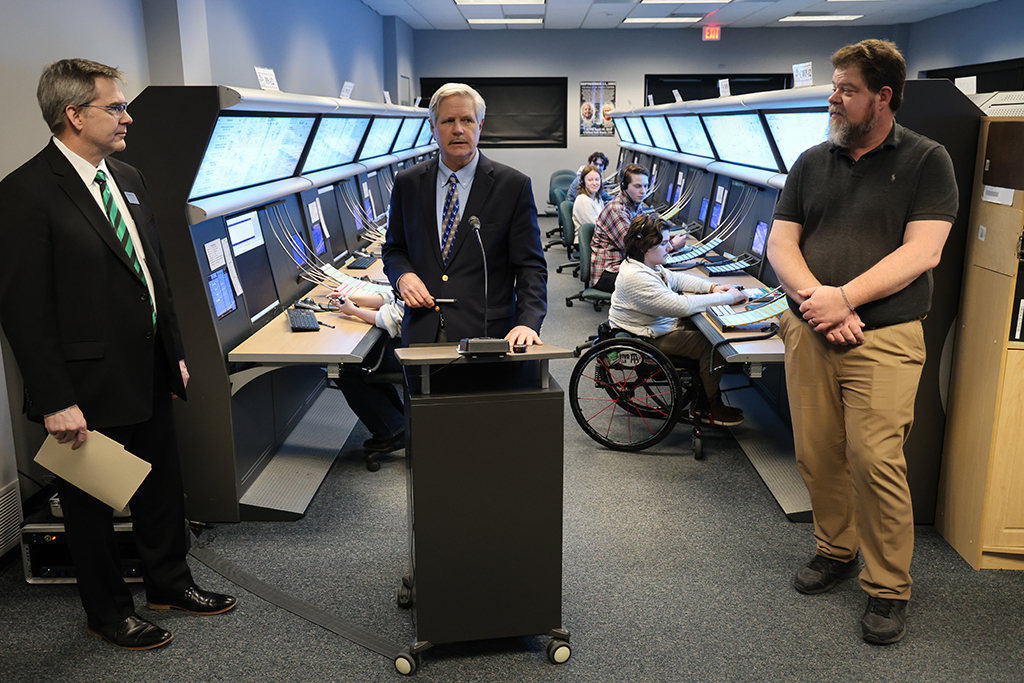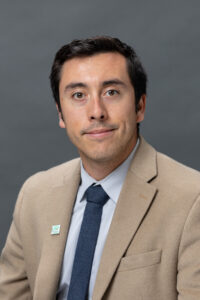UND poised to help fill shortage of air traffic controllers
Under new FAA initiative, UND’s Air Traffic Management grads may be able to bypass FAA Academy, begin careers at air traffic control facility

Editor’s note: In the UND LEADS Strategic Plan, the Learning core value calls on the University to provide “curricular, co-curricular, and experiential learning opportunities where students can practice and refine essential skills needed for successful careers and engaged lives as global citizens.” The story below, which UND Today first published on March 5, shows that the University helps Air Traffic Management students learn their “essential skills” so effectively, those students soon may be able to entirely bypass the FAA Academy — previously, a required step in the path to becoming an air traffic controller.
****
On March 1, North Dakota’s senior senator visited UND to tout the benefits of a new Federal Aviation Administration (FAA) program for students and the flying public alike.
Speaking at Ryan Hall’s Air Traffic Control Radar Lab on the UND campus, U.S. Sen. John Hoeven joined UND Provost Eric Link and Craig Carlson, assistant chair of UND’s Air Traffic Management program, to outline how the FAA’s Enhanced Air Traffic College Training Initiative could give UND students a fast track to airport control towers.
Under current regulations, all prospective air traffic controllers are required to attend the FAA Academy in Oklahoma City, regardless of educational background or work experience. Hoeven called this requirement a “bottleneck,” one that is impeding further growth in air travel at a time of high demand.
“Anyone watching the news knows we’re short of air traffic controllers, and that creates potential safety issues,” he said. “This is vitally important to the traveling public for the United States of America. This school is going to lead the way forward to solve that problem.”
Link agreed. “This will give students such as these a chance to get directly out there, helping our pilots navigate the skies, land safely and keep safe all of the folks, freight and everyone who needs passage through our crowded airways,” he said. “And that’s because of the training they get right here at the University of North Dakota.”
Hoeven’s comments appear to be backed by data. According to a report from the U.S. Department of Transportation, the agency that oversees the FAA, 20 out of the nation’s 26 critical air traffic control centers are staffed below the FAA’s threshold of 85%.
Carlson added that due to staffing shortages, multiple control centers across the nation have been forced to limit the traffic that can pass through their airspace. He cited the New York Terminal Radar Approach Control (TRACON) and Jacksonville Center as locations that are especially understaffed.
UND is already a member of the FAA’s Air Traffic College Training Initiative (AT-CTI), as are 31 other schools. Membership in this program confers a number of benefits, among them the fact that graduates can shorten their training at the FAA Academy by five weeks.
But if UND is admitted into the new Enhanced AT-CTI, the University’s Air Traffic Management graduates would be able to bypass the academy altogether and begin on-the-job training at an air traffic control facility, pending successful completion of the Air Traffic Skills Assessment Exam and medical assessments.
Hoeven’s visit was attended by students and recent graduates in air traffic management, who expressed frustration with the lengthy admissions process into the FAA Academy.
Aundraya Johnson and Danny Lilya – both recent graduates of UND’s air traffic management program – said they anticipate at least a year-long wait before being admitted to the academy. In the meantime, the pair are working as air traffic management associates, helping students navigate their way through the program.
Hoeven highlighted the potential increase in value of the degree, should UND be admitted into the Enhanced AT-CTI.
“If you could get your education here and go right into air traffic control, would you do that?” Hoeven asked students present.
“That would be amazing,” replied junior Ella Centola, who said she is weighing her decision to pursue a career as an air traffic controller on whether the requirement to attend the FAA Academy is still in place when she graduates.

Carlson opined that enrollment in the program – currently around 100 students – could triple in the coming years if UND’s application is successful.
“I think that’s going to be the ultimate benefit for the University of North Dakota and our air traffic control program: more students,” he said. “We started the program in 1991 and graduated our first class in 1993 of nine people. Way back then, the graduates did go directly to a facility as part of a five-university test program. That was successful and has expanded several times to where we’re at now.”
Applications to join the Enhanced AT-CTI program will open on April 1, at which point Carlson said UND will work to ensure it is in compliance with the technical and curricular requirements for admittance. He said the university intends to be the first to apply.
Hoeven added it is only natural for an institution with such a rich history in aviation to pioneer this new program.
“The FAA is encouraging you guys to apply,” he said. “They need the best school leading the way. To make it work, you have to start with the best.”
****
>> QUESTIONS OR COMMENTS about the UND LEADS Strategic Plan? Your thoughts are welcome! Please contact Angie Carpenter, UND’s director of Special Student Populations, and/or Ryan Zerr, associate vice president for Strategy & Implementation, the co-chairs of the UND LEADS Implementation Committee.
You also may offer your thoughts by visiting the UND LEADS Strategic Plan home page and clicking on the “Provide your feedback” link that you’ll find there.
Thank you for your support of the UND LEADS Strategic Plan!



